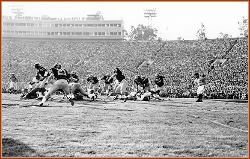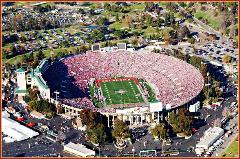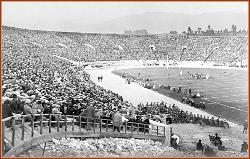



Ford Field History
The 2002 season marked a new era in Detroit Lions history when the team opened its
new downtown Detroit stadium, Ford Field, one of the most impressive sports and
entertainment venues ever built.
The Lions’ home is an incomparable 65,000-seat facility that includes a giant glass
wall, revealing the picturesque Detroit skyline, and the old Hudson’s Warehouse,
originally built in 1920. The massive project encompasses a total of 1.85 million
square feet of development.
The old Hudson’s Warehouse, a major cornerstone of Ford Field, houses most of the
stadium luxury seats, press box, restaurants, food courts, lounge areas, banquet
facilities, entertainment venues and commercial space. The inclusion of the
warehouse into the stadium project allows the sightlines at Ford Field to be among the
very best in the NFL. In fact, the locker room facilities have been built in the basement
of the seven-story historic Detroit structure.
Detroit played its first home preseason game at Ford Field on August 24, 2002
against the Pittsburgh Steelers. The Lions celebrated their inaugural regular season
game at Ford Field on September 22, 2002 when they hosted their long-time
divisional rival Green Bay Packers. The 2002 home opener marked the return of the
Lions to downtown Detroit for the first time since 1974.
The Lions won their first game at Ford Field on September 29, 2002 when they
defeated the New Orleans Saints, 26-21.
Prior to opening, Ford Field captured the attentive eye of NFL owners. On November
1, 2000, they unanimously selected Ford Field to be the host site of Super Bowl XL to
be played February 5, 2006. It will mark the first Super Bowl in the Detroit Metro area
since the Pontiac Silverdome was the site for Super Bowl XVI, played January 24,
1982.
The NCAA also took notice of Ford Field and selected the stadium to host the 2009
Men’s Basketball Final Four. Ford Field got its first taste of basketball on December
14, 2003 when the Michigan State Spartans hosted the University of Kentucky
Wildcats in ‘The BasketBowl’. The BasketBowl drew 78,129 fans, a world-record
setting attendance for a basketball game.
College football will return to Ford Field on September 4, 2004 with the second annual
Detroit Football Classic, which will feature a match-up between Alabama State and
Howard. Last December, the second Motor City Bowl was played at Ford Field with
Bowling Green defeating Northwestern, 28-24.
Earlier in 2003, Ford Field hosted the NFL Draft Day Experience, the Lions’ 15th
annual draft day fan gala which brought more than 8,600 fans to downtown Detroit.
The stadium has been utilized for many non-sports events as well. Detroit native
Eminem hosted two concerts in July 2003 that drew nearly 100,000 people to the
venue. Ford Field hosted its first major concert on October 12, 2002 when the
legendary Rolling Stones performed.

Detroit lit up during the Super Bowl.
|
An artist rendering of what Detroit's Ford Field would look like
before it was built.
|
Ford Field right before the home opener in 2004.
|
Quick Facts
Name: Ford Field
Location: Detroit, MI
Tenant: Detroit Lions
Capacity: 65,000
Surface: Fieldturf
Construction Began:
November 16, 1999
Opened: September
22, 2002
Cost: $430 Million
Architect: SHG, Inc.,
Rossetti Associates
Architects, Hamilton
Anderson Associates
Ford Field Design
Ford Field was planned simultaneously with Comerica Park, which opened in April 2000, as part of a public project to replace Tiger Stadium and
the Pontiac Silverdome. Ford Field was constructed after Comerica Park, opening in 2002. It cost an estimated $430 million to build, financed
largely through public money and the sale of the naming rights.
The stadium's design incorporates a six-story former J.L. Hudson's warehouse, which had stood since the 1920s. Architecturally, the stadium
shares a likeness with its sister stadium Ford Center, a multipurpose sports/concert arena located in downtown Oklahoma City.
The presence of the warehouse allows for a seating arrangement that was unique among professional American football stadiums at the time of
Ford Field's opening. The majority of suites at Ford Field are located in the Hudson Warehouse along the stadium's southern sideline, as are
the lounges that serve the premium club seats on that side of the field. The bulk of the grandstand seats are located along the northern sideline
and both endlines, with gaps in the stadium's upper half at the southwest and southeast corners. The upper deck on the stadium's northern
sideline also contains one level of suites and a smaller section of club seating. A similar design was implemented at the renovated Soldier Field,
albeit with the use of a new structure (as opposed to an existing building) to house four levels of suites.
Unlike most indoor stadiums, Ford Field allows a large amount of natural light to reach the playing field, thanks to immense skylights and large
glass windows at the open corners. The southwest corner provides the seating bowl and concourse with sunlight year-round and also offers fans
a view of downtown Detroit. To prevent the stadium from becoming an overly imposing presence in the Detroit skyline, the playing field and lower
bowl (100 level) were set below street level, similar to the design at adjacent Comerica Park.
Ford Field features a FieldTurf playing surface made from recycled Firestone tires.










